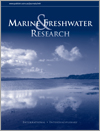Marine and Freshwater Research
Volume 73
Number 12 2022
Indigenous co-management of environmental water generates significant cultural and environmental benefits. We map environmental watering events in the Murray–Darling Basin onto the boundaries of state-determined Indigenous organisations. We then discuss how this relates to varying levels of Indigenous engagement in environmental watering decisions across the Basin. To address the issues highlighted, we suggest policy pathways that could be implemented in upcoming reviews of the Water Act and the Basin Plan.
Town proximity was used to evaluate the effect of fishing pressure on golden perch populations in refuge waterholes of the northern Murray–Darling Basin. This study shows a fishing pressure ‘gradient’ with an increasing distance from town. Fishing pressure is shown to have a significant effect on the size structure of golden perch in refuge waterholes.
We conducted a microplastics survey along a stretch of the Paraíba do Sul River basin, the water system of which flows through the most populous area in Brazil. Samples were taken from the superficial layer of the water column in high-water and low-water periods 2021. The microplastics in the surface waters of the Paraíba do Sul River is significantly influenced by the rainfall regime.
This research describes distribution, movements, site fidelity and estimates of growth rates for the bronze whaler shark (Carcharhinus brachyurus) in southern Africa. Movements provided further evidence of population connectivity in the region. Large-scale movements highlighted the mobility of the species, but most sharks were recaptured within 100 km of tagging location, indicating strong site fidelity with nursery areas described in South Africa. The slow growth rates modelled here, coupled with high site fidelity, suggest that the species is vulnerable to overexploitation.
Golfo Dulce is a wintering ground of the south-eastern Pacific population of humpback whales (Megaptera novaeangliae). The aim of this study was to determine spatial segregation and habitat use depending on humpback whale group composition (groups that included mother–calf dyads v. adult-only groups) from June to October, 2010–2019. Spatial partitioning of habitat among humpback whale groups depended on group composition and reproductive behaviours. These habitat-use patterns should be considered when designing effective conservation strategies for marine spatial planning.
A 35-year survey showed that yield depends on environmental variables. Overfishing is not always the main factor reducing fishery yields, but it is a flaw in traditional policies. Complying with environmental thresholds assures the sustainability of fisheries. Intersectoral action is required for the sustainability of the fisheries.
This paper tests speculation that the some aspects of the behaviour of Australian mayflies differs from those of species in the northern hemisphere, on the basis of multi-year studies in Tasmania. The results indicated that most elements of their behaviour are similar, but that the life histories of Tasmanian species could be more sensitive to ecological factors than physiological ones.
The effect of calcium on the toxicity of saline solution to a mayfly species Austrophlebioides sp. AV11 was studied. There was a decrease in toxicity when calcium chloride and calcium sulfate were used together, but there was an increase with calcium chloride and no significant difference with calcium sulfate. The decrease in toxicity occurred with a two-fold and four-fold increase in calcium, but there was no observable decrease with an eight-fold increase, suggesting that there is a threshold in the effect of calcium on the toxicity of saline solution.
Two exotic snail species, the ‘apple snail’ and the ‘assassin snail’, pose a particular threat to Australian freshwater ecosystems. In this study, we determined the ranges of temperature and salinity tolerances for these two species after acclimation to different conditions. Our results indicated that these species can tolerate temperatures and salinities that would allow them to survive in many Australian temperate and subtropical environments.
Australia has the third largest marine jurisdiction of any country but we know very little about its deepest parts. We found that almost half of Australian waters (excluding Antarctic waters) are deeper than 3000 m, of which a third is within Australian Marine Parks. Australia’s deep sea may be protected, but Australian scientists and research institutes should focus on establishing long-term research programs to understand what is there and whether it is changing.





